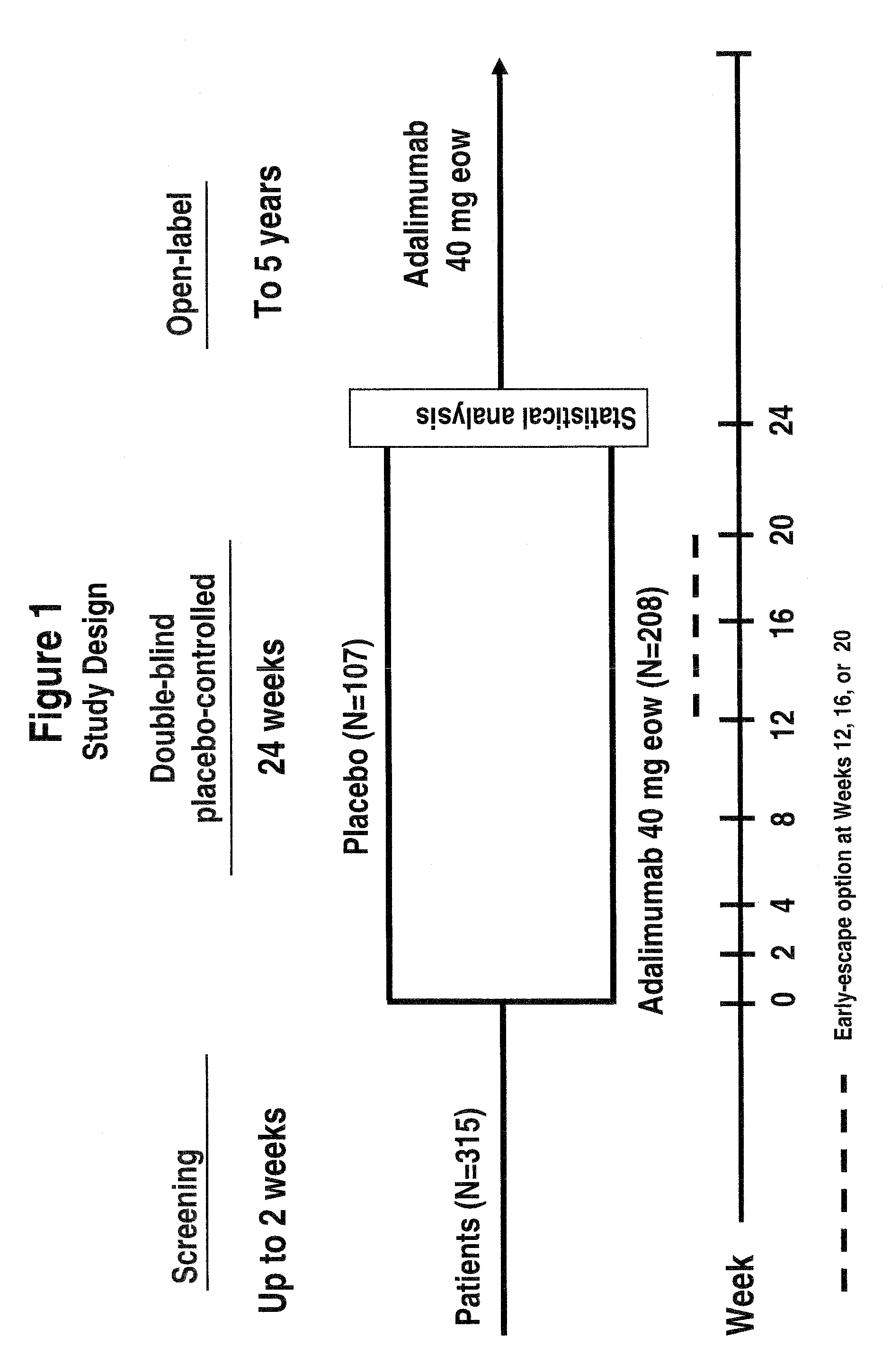Uses and compositions for treatment of ankylosing spondylitis
a technology for ankylosing spondylitis and compositions, applied in the field of use and compositions for treating ankylosing spondylitis, can solve the problems of pain, joint stiffness, eventual loss of spinal mobility, functional limitations, etc., and achieve the effect of improving the fatigue and pain associated, safe and effective treatment, and improving the effect of fatigue and pain
- Summary
- Abstract
- Description
- Claims
- Application Information
AI Technical Summary
Benefits of technology
Problems solved by technology
Method used
Image
Examples
example 1
Pharmacokinetics of Adalimumab in Patients with Active Ankylosing Spondylitis (AS)
[0287]Ankylosing spondylitis (AS) is a chronic, inflammatory, progressive disease with considerable impact on patient functional status and well-being that affects the axial skeleton, large peripheral joints, and enthuses that results in restricted spinal mobility. The mechanism of action of adalimumab for AS indication is anti-TNF mediated.
[0288]This study evaluated adalimumab exposure, immunogenicity, and the potential impact of immunogenicity on efficacy and safety in patients with active AS treated with adalimumab.
[0289]Study H was a trial using adalimumab evaluating long-term efficacy and safety in AS, and was a randomized, placebo-controlled, Phase III study involving patients ≧18 years of age with AS, based on modified New York criteria, who had a inadequate response or intolerance to 1 NSAID and might have failed one or more DMARDs. Active AS, was as diagnosed by 2 of the 3 following symptoms: ...
example 2
Long-Term Efficacy and Safety of Adalimumab in the Treatment of Active Ankylosing Spondylitis
Results of an Open-Label, 2-Year Trial
[0299]The tumour necrosis factor (TNF) antagonist adalimumab has been shown to be highly efficacious in the short-term treatment of ankylosing spondylitis (AS) (Haibel et al. Arthritis Rheum 2006; 54:678). The objective of this study was to examine the therapeutic effects of adalimumab in a subpopulation of hard to treat patients, i.e., NSAID-refractory AS patients.
[0300]Fifteen patients (9 males, 6 females; mean age 40 years, range 19-55; mean disease duration 11 years, range 2-33; 86% HLA-B27 positive) with active disease (mean Bath Ankylosing Spondylitis Activity Index or BASDAI of 6.6, range 4.7-8.5) enrolled in the trial. All patients suffered from spinal pain, and 4 patients also had peripheral arthritis. Adalimumab 40 mg was administered subcutaneously every other week (eow). Clinical outcome assessments included disease activity (BASDAI), functio...
example 3
Improvements in Health Related Quality of Life (HRQL) Correlate Positively with Clinical Reponses in Ankylosing Spondylitis (AS) Patients
[0304]A study was performed to evaluate the relationship between clinical response criteria (treatment efficacy) and HRQL improvements in patients with active AS.
[0305]Data were from Study H, a Phase III study in which patients were randomized to either adalimumab (ADA) 40 mg every other week or placebo (PBO) for 24 weeks. Early-escape option to open-label 40 mg adalimumab sc eow was available at Week 12, or 16, or 20 (see FIG. 1 for Study H design). For this analysis, patients were categorized into mutually exclusive groups by Assessment in Ankylosing Spondylitis (ASAS) 20 / 50 / 70 or Bath Ankylosing Spondylitis Disease Activity Index (BASDAI) 20 / 50 / 70 criteria, based on Week 12 visit data. HRQL measures include baseline (BL) and Week 12 data of the SF-36 Health Survey and the AS Quality of Life (ASQoL). A change of ≧3 for SF-36 physical summary comp...
PUM
| Property | Measurement | Unit |
|---|---|---|
| concentration | aaaaa | aaaaa |
| concentration | aaaaa | aaaaa |
| concentration | aaaaa | aaaaa |
Abstract
Description
Claims
Application Information
 Login to View More
Login to View More - R&D
- Intellectual Property
- Life Sciences
- Materials
- Tech Scout
- Unparalleled Data Quality
- Higher Quality Content
- 60% Fewer Hallucinations
Browse by: Latest US Patents, China's latest patents, Technical Efficacy Thesaurus, Application Domain, Technology Topic, Popular Technical Reports.
© 2025 PatSnap. All rights reserved.Legal|Privacy policy|Modern Slavery Act Transparency Statement|Sitemap|About US| Contact US: help@patsnap.com



